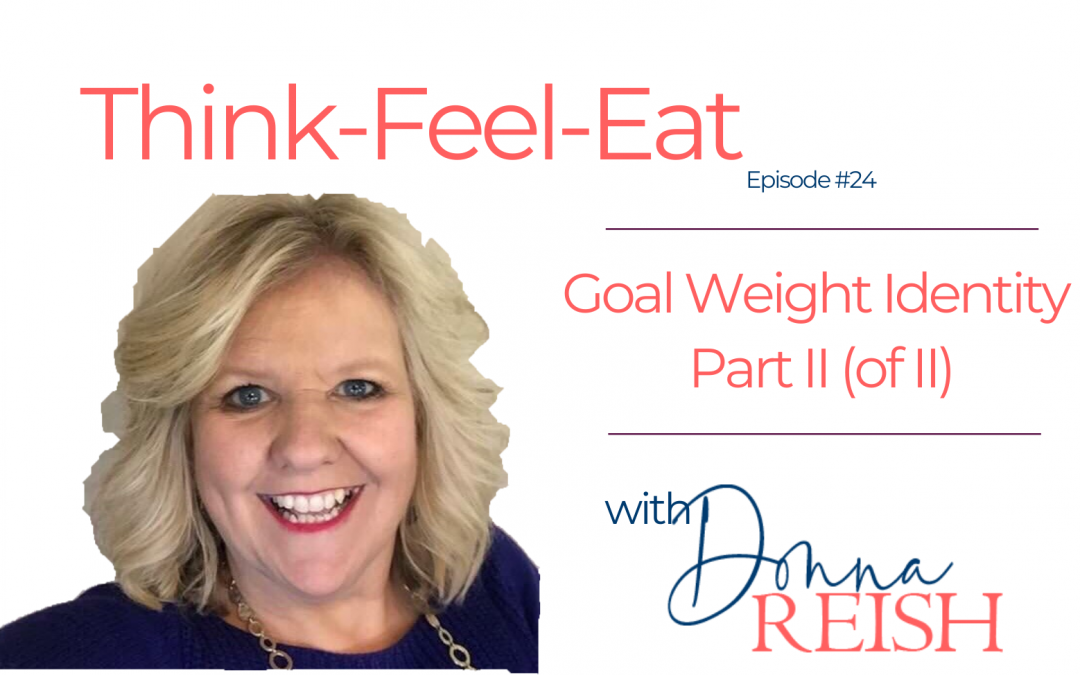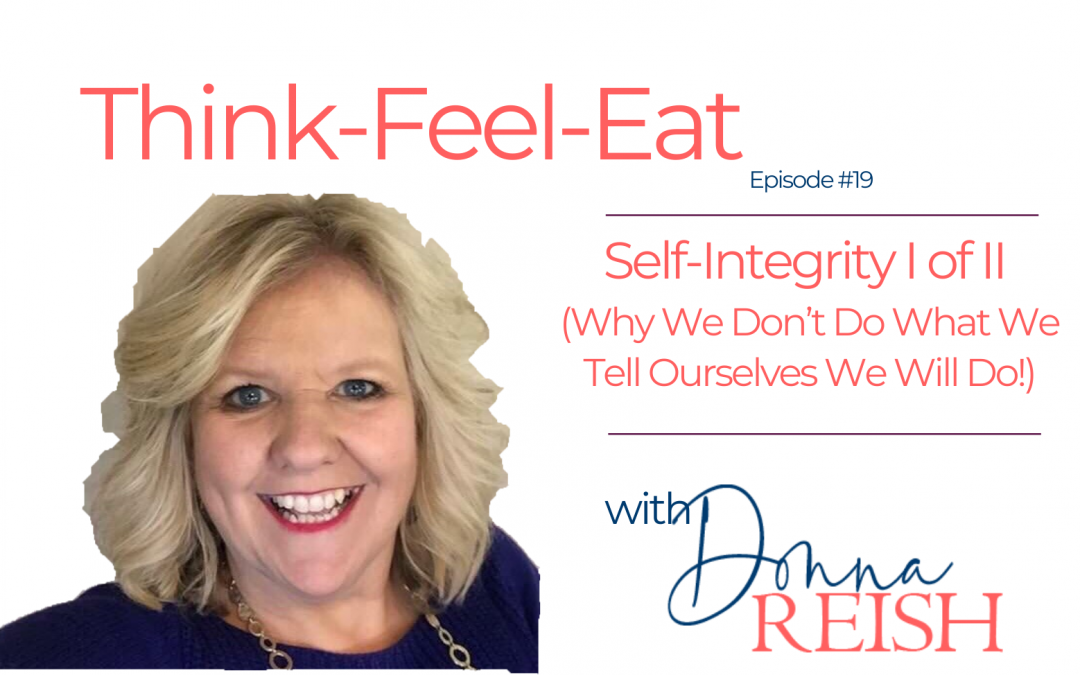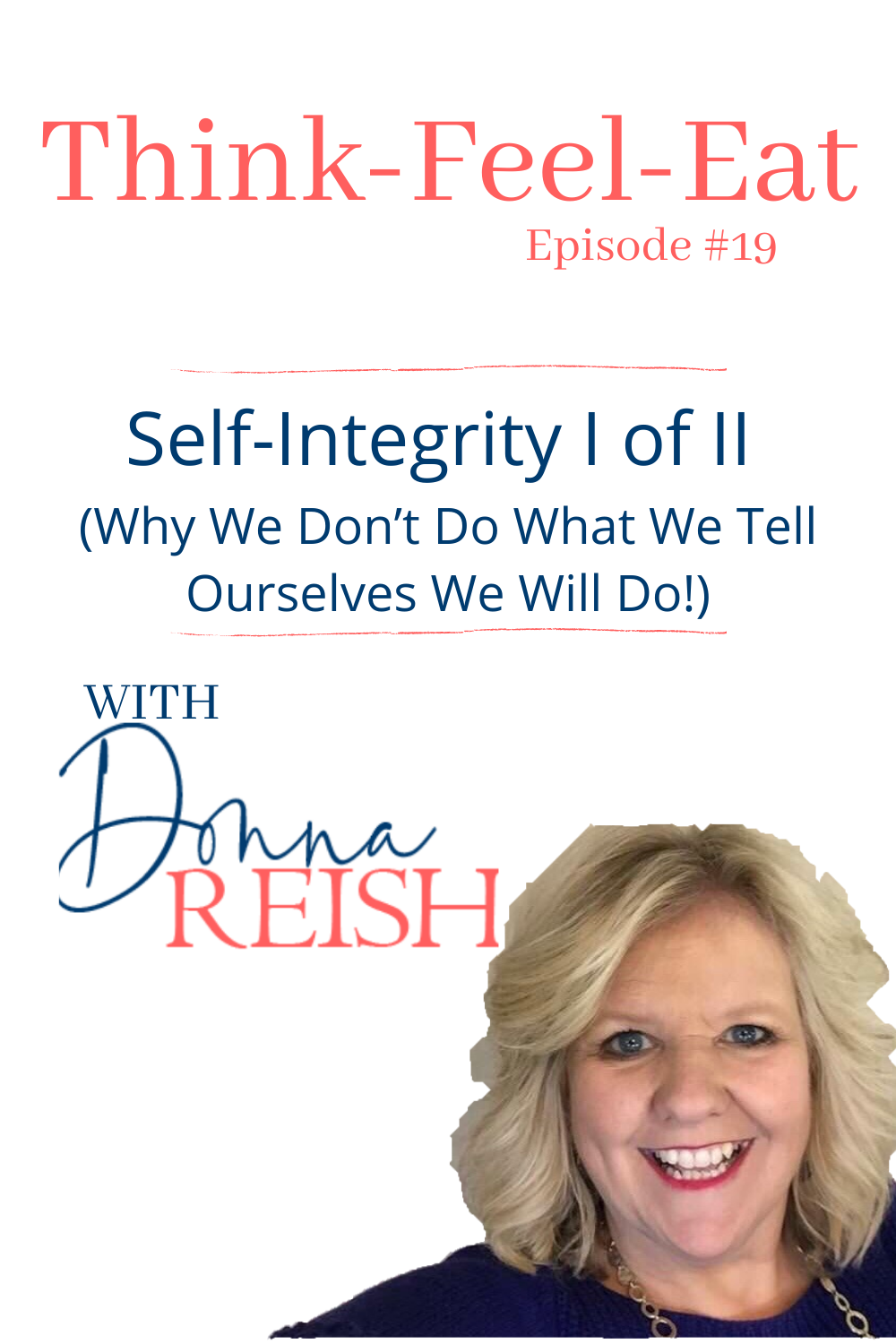
Think-Feel-Eat Episode #25: Self-Sabotage in Weight Loss Part I (of II)
Hi! I’m Donna Reish, IF teacher, weight loss coach, blogger, and half of “The Minus 220 Pound Pair” as my husband and I have lost over 220 pounds together (160 of that in the past couple of years through the Weight Loss Lifestyle habits and strategies I teach!).
In this episode, I shed some light on that common term, self-sabotage. In weight loss terms, this is used to say that we thwart our own efforts at losing weight.
But what does it mean? Is it helpful to use that term? (Language Arts Lady says that words and thoughts DO matter!)
I start out defining self-sabotage then explaining what the term really is—a euphemism for little quits, giving up, giving in, choosing something besides our goals in that moment, etc.
Euphemisms are words that help soften the reality of that moment. They are helpful for us in dealing with crises, loss, and more—and should be used in those instances. However, when it comes to what we call deviations from our plan, euphemisms are not very helpful.
We would do a lot less self-sabotaging if we called our deviations what they really are—going off plan or choosing a food in the moment rather than our long term goals during that moment. AND extending grace to ourselves as we do it (as opposed to “beating ourselves up” for our deviations).
Next I move into what “self-sabotages” start with—a Thought. They start with a Thought such as “this won’t matter” or “a bite won’t hurt” or “I’ll start Monday.” I teach the importance of capturing that Thought in the moment and how we can replace it with a Pocket Thought (a thought we have prepared ahead of time and store in our “pocket” for a “rainy day”!).
Another anti-self-sabotage tip I teach is that of learning how to “sit with urges” rather than trying to use will-power or white knuckling through them. If we know they are coming, and we are ready for them, we can sit with them more easily. (Find more about this in “10 Ways to Sit With Urges” in Think-Feel-Eat Episode #9.)
Finally, the last two tips have to do with two of my favorite weight loss strategies: Deciding Ahead of Time and Creating a Protocol. (More on both of these can be found at donnareish.com/perfectstorm)
Join me next week in Episode #26 for Part II of the Self-Sabotage two parter—specific food and daily tips to stay on—and stop “obstructing your own weight loss efforts.”
Find all of my episodes, outlines, and articles for my two weekly broadcasts:
(1) Weight Loss Lifestyle broadcast (formerly Donna’s Intermittent Fasting Broadcast)
Sign up for my free webinar: intermittentfastingwebinar.com
Think Feel Eat 25 Self-Sabotage Part I (of II)
A. Definition
1. According to Psychology Today: Behavior is said to be self–sabotagingwhen it creates problems in daily life and interferes with long-standing goals. The most common self–sabotaging behaviors include procrastination, self-medication with drugs or alcohol, comfort eating, and forms of self-injury such as cutting.
2. Language Arts Lady—take it apart
a. Self—me; myself; done by me
b. Sabotage—deliberately destroying, damaging, or obstructing
3. For our purposes, we will call it “when I deliberately (or unknowingly—more on that later) obstruct my weight loss/maintenance or health progress.”
B. Euphemisms in Weight Loss
1. Euphemisms are words we use to soften the blow or lighten the real thing that is happening.
2. We use euphemisms to make something seem or feel less severe than it is
a. Left me or doesn’t want to see me—instead of dumped me
b. Passed on, we lost him—instead of died
3. The problem of doing this with weight loss
a. Makes it seem like it is typical behavior
b. Makes it seem like it isn’t very serious or important
c. Makes it seem commonplace
d. Makes it seem inevitable
e. Makes it seem like it is outside of our control
4. Euphemisms in weight loss that are not serving us
a. Fell off the wagon
b. Got off track
c. X overtook me (cravings, etc.)
d. Lost my willpower
e. I always self-sabotage
f. The cupcakes were calling my name
5. Say exactly what is happening—without beating ourselves up or tearing ourselves down
a. Not I always self-sabotage but instead I always CHOOSE
b. Not I fell off the wagon, but instead I DECIDED
c. Not I lost my willpower, but instead I gave up my goals and did X
d. Not something overtook me, but instead I wanted X more than X
e. State it as a fact—not as a personal defect!
C. Self-Sabotage Starts With a Thought
1. The Thought right before we engage in the behavior that sabotages or obstructs us from our goals
2. This “right before the behavior” thought is the one we need to take hold of and change
3. Ways to end self-sabotage
a. Call it what it is: little quits, giving up, giving in, choosing, deciding, going off plan….use the pronoun I…
b. Work on Thoughts ahead of time
c. Make decisions ahead of time with your pre-frontal cortext
d. Have firm protocol in place so you know when you are going off and what that will look like
e. Have a mechanism in place to end self-sabotaging behaviors before they get out of hand
f. Don’t ever have “screw it” times again—instead plan exactly what you will do in unusual circumstances
g. Use “tricks” to keep you on the protocol you have chosen
D. Ways to End Self-Sabotage (or Ways to End Giving Up!)
1. Call it what it is
a. Little quits, giving up, giving in, choosing, deciding, going off plan
b. Use the pronoun I
c. Don’t use euphemisms
d. Don’t adopt typical diet slang
2. Work on Thoughts ahead of time
a. Obstructing your progress starts with a Thought
b. What is that Thought right before you obstruct your progress?
i. This won’t matter
ii. A bite won’t hurt
iii. I’ll start tomorrow
iv. I’ll start Monday
v. I’m not losing now anyway
vi. Doesn’t matter what I eat—you can lose weight eating anything (true….but can you STOP eating just anything?)
c. Get a Thought or two ready!
i. Every bite DOES matter
ii. I can choose to do something different tomorrow; today is already planned
iii. Starting later has never worked for me
d. Use one of the 10 Tips to Sit With Urges (TFE #9)
3. Make decisions ahead of time with your “adult brain”—pre-frontal cortex
a. This keeps you from having to use willpower to so much (WLL 60 and WLL 61)
b. This allows you to plan the day ahead of time (Get your freebie journal sheet here!)
i. TFE: The One BIG Decision to Make Ahead of Time
ii. TFE: The Daily Decision to Make for Weight Loss
c. This allows you to decide something different on another day. “There’s always tomorrow!” is a helpful thought when you have already decided ahead of time.
4. Have firm protocol in place so you know when you are going off and what that will look like
a. People who are successful at weight loss/maintenance aren’t perfect; they’re just on way more than they are off!
b. 80/20 works—it’s 70/30 or 60/40 that doesn’t work
c. When protocol is firmly in place, it is obvious “I’m going off for this wedding”—or “I’m staying on protocol completely even when we got out for dinner this week”
d. You don’t “fall off a wagon”—there will be no wagon to fall off of…this is your way of life 80% of the time…more often than not…how you live.
E. Next Steps
1. Tools for Self-Sabotaging Behaviors next week! TFE 26!
2. Intermittent Fasting Course—first Monday of each month; use code SAVE20 to get $20 off: intermittentfastingcourse.com






































